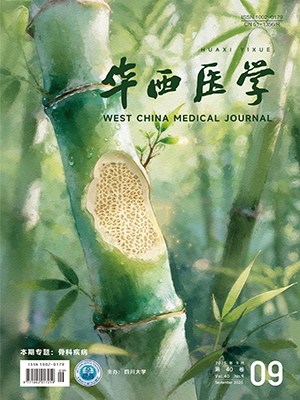| 1. |
《中國腦卒中防治報告 2021》編寫組. 《中國卒中防治報告 2021》概要. 中國腦血管病雜志, 2023, 20(11): 783-793.
|
| 2. |
Oyake K, Baba Y, Ito N, et al. Cardiorespiratory factors related to the increase in oxygen consumption during exercise in individuals with stroke. PLoS One, 2019, 14(10): e0217453.
|
| 3. |
Boss HM, Deijle IA, Van Schaik SM, et al. Cardiorespiratory fitness after transient ischemic attack and minor ischemic stroke: baseline data of the moveit study. J Stroke Cerebrovasc Dis, 2017, 26(5): 1114-1120.
|
| 4. |
錢貞, 阮秋香, 何俊, 等. 腦卒中患者心肺功能及其影響因素研究. 實用心腦肺血管病雜志, 2019, 27(11): 11-15, 20.
|
| 5. |
Rikli RE, Jones CJ. Development and validation of criterion-referenced clinically relevant fitness standards for maintaining physical independence in later years. Gerontologist, 2013, 53(2): 255-267.
|
| 6. |
Billinger SA, Arena R, Bernhardt J, et al. Physical activity and exercise recommendations for stroke survivors: a statement for healthcare professionals from the American Heart Association/American Stroke Association. Stroke, 2014, 45(8): 2532-2553.
|
| 7. |
Saunders DH, Greig CA, Mead GE. Physical activity and exercise after stroke: review of multiple meaningful benefits. Stroke, 2014, 45(12): 3742-3747.
|
| 8. |
劉昆. 制動與運動、康復評價與康復訓練的研究進展. 中國臨床康復, 2002, 6(2): 174-176.
|
| 9. |
Wei X, Sun S, Zhang M, et al. A systematic review and meta-analysis of clinical efficacy of early and late rehabilitation interventions for ischemic stroke. BMC Neurol, 2024, 24(1): 91.
|
| 10. |
AVERT Trial Collaboration group. Efficacy and safety of very early mobilisation within 24 h of stroke onset (AVERT): a randomised controlled trial. Lancet, 2015, 386(9988): 46-55.
|
| 11. |
Kramer SF, Cumming T, Johnson L, et al. Determining maximal tolerable aerobic training intensity in the acute phase after stroke: a novel dose ranging trial protocol. J Stroke Cerebrovasc Dis, 2020, 29(12): 105359.
|
| 12. |
Luo L, Meng H, Wang Z, et al. Effect of high-intensity exercise on cardiorespiratory fitness in stroke survivors: a systematic review and meta-analysis. Ann Phys Rehabil Med, 2020, 63(1): 59-68.
|
| 13. |
Tollár J, Nagy F, Csutorás B, et al. High frequency and intensity rehabilitation in 641 subacute ischemic stroke patients. Arch Phys Med Rehabil, 2021, 102(1): 9-18.
|
| 14. |
Lamberti N, Straudi S, Malagoni AM, et al. Effects of low-intensity endurance and resistance training on mobility in chronic stroke survivors: a pilot randomized controlled study. Eur J Phys Rehabil Med, 2017, 53(2): 228-239.
|
| 15. |
Horváth J, Debreceni Nagy A, Fül?p P, et al. Effectiveness of hospital-based low intensity and inspected aerobic training on functionality and cardiorespiratory fitness in unconditioned stroke patients: importance of submaximal aerobic fitness markers. Medicine (Baltimore), 2022, 101(42): e31035.
|
| 16. |
楊倩, 劉邦忠. 腦卒中患者適宜運動劑量的研究進展. 中華物理醫學與康復雜志, 2022, 44(9): 848-851.
|
| 17. |
Kim BR, Han EY, Joo SJ, et al. Cardiovascular fitness as a predictor of functional recovery in subacute stroke patients. Disabil Rehabil, 2014, 36(3): 227-231.
|
| 18. |
Scheitz JF, Nolte CH, Doehner W, et al. Stroke-heart syndrome: clinical presentation and underlying mechanisms. Lancet Neurol, 2018, 17(12): 1109-1120.
|
| 19. |
Gambassi BB, Coelho-Junior HJ, Paix?o Dos Santos C, et al. Dynamic resistance training improves cardiac autonomic modulation and oxidative stress parameters in chronic stroke survivors: a randomized controlled trial. Oxid Med Cell Longev, 2019, 2019: 5382843.
|
| 20. |
Pang MY, Eng JJ, Dawson AS, et al. The use of aerobic exercise training in improving aerobic capacity in individuals with stroke: a meta-analysis. Clin Rehabil, 2006, 20(2): 97-111.
|
| 21. |
蘇醒, 王潔, 劉義鋒, 等. 40 歲以上人群缺血性卒中風險現況調查及預測模型的構建. 河南醫學研究, 2024, 33(2): 277-280.
|
| 22. |
李鍵, 程迎, 胡丹丹, 等. 腦卒中心肺適能康復研究進展. 中國臨床研究, 2023, 36(9): 1397-1401, 1406.
|
| 23. |
劉遂心. 心肺運動試驗: 有氧運動處方的制定. 臨床心電學雜志, 2017, 26(4): 247-248.
|
| 24. |
Mustafa E, Aytür YK. Assessment for cardiovascular fitness in patients with stroke: which cardiopulmonary exercise testing method is better?. Top Stroke Rehabil, 2022, 29(5): 347-355.
|
| 25. |
錢貞, 盧同波, 何俊, 等. 精準化運動處方對卒中患者心肺適能及睡眠質量的影響研究. 中國全科醫學, 2022, 25(20): 2468-2474.
|
| 26. |
ATS Committee on Proficiency Standards for Clinical Pulmonary Function Laboratories. ATS statement: guidelines for the six-minute walk test. Am J Respir Crit Care Med, 2002, 166(1): 111-117.
|
| 27. |
Marzolini S, Oh P, McIlroy W, et al. The feasibility of cardiopulmonary exercise testing for prescribing exercise to people after stroke. Stroke, 2012, 43(4): 1075-1081.
|
| 28. |
Brito SAF, Aguiar LT, Garcia LN, et al. Cardiopulmonary exercise testing and aerobic treadmill training after stroke: feasibility of a controlled trial. J Stroke Cerebrovasc Dis, 2020, 29(7): 104854.
|
| 29. |
楊青青, 周明超, 王玉龍. 腦卒中患者心肺運動試驗評估方法的研究進展. 中華物理醫學與康復雜志, 2023, 45(6): 558-562.
|
| 30. |
中華醫學會心血管病學分會, 中國康復醫學會心肺預防與康復專業委員會, 中華心血管病雜志編輯委員會. 心肺運動試驗臨床規范應用中國專家共識. 中華心血管病雜志, 2022, 50(10): 973-986.
|
| 31. |
Stoller O, de Bruin ED, Schindelholz M, et al. Cardiopulmonary exercise testing early after stroke using feedback-controlled robotics-assisted treadmill exercise: test-retest reliability and repeatability. J Neuroeng Rehabil, 2014, 11: 145.
|
| 32. |
錢貞, 陳偉. 心肺運動試驗在卒中患者心肺功能評估中的研究進展. 臨床與病理雜志, 2018, 38(3): 641-646.
|
| 33. |
徐泉, 潘鈺, 張嘯飛, 等. 腦卒中偏癱患者心肺運動功能評估臨床研究. 中國康復醫學雜志, 2016, 31(12): 1334-1338.
|
| 34. |
Fulk GD, Echternach JL, Nof L, et al. Clinometric properties of the six-minute walk test in individuals undergoing rehabilitation poststroke. Physiother Theory Pract, 2008, 24(3): 195-204.
|
| 35. |
中華醫學會心血管病學分會, 中國康復醫學會心肺預防與康復專業委員會, 中華心血管病雜志編輯委員會. 六分鐘步行試驗臨床規范應用中國專家共識. 中華心血管病雜志, 2022, 50(5): 432-442.
|
| 36. |
Macchiavelli A, Giffone A, Ferrarello F, et al. Reliability of the six-minute walk test in individuals with stroke: systematic review and meta-analysis. Neurol Sci, 2021, 42(1): 81-87.
|
| 37. |
滕寶梅, 郭媛. 心肺耐力評估方法及應用研究進展. 臨床醫學進展, 2023, 13(3): 3744-3751.
|
| 38. |
Humbert M, Kovacs G, Hoeper MM, et al. 2022 ESC/ERS guidelines for the diagnosis and treatment of pulmonary hypertension. Eur Respir J, 2023, 61(1): 2200879.
|
| 39. |
Quintino LF, Aguiar LT, de Brito SAF, et al. Reliability and validity of the incremental shuttle walking test in individuals after stroke. Top Stroke Rehabil, 2021, 28(5): 331-339.
|
| 40. |
Azman MZB, Huang KS, Koh WJ, et al. Normative reference values, determinants and regression equations for the incremental shuttle walk test (ISWT) in healthy Asian population aged 21 to 80 years. PLoS One, 2023, 18(9): e0291132.
|
| 41. |
Dite W, Langford ZN, Cumming TB, et al. A phase 1 exercise dose escalation study for stroke survivors with impaired walking. Int J Stroke, 2015, 10(7): 1051-1056.
|
| 42. |
Galloway M, Marsden DL, Callister R, et al. How little is enough? The feasibility of conducting a dose-escalation study for exercise training in people with stroke. J Stroke Cerebrovasc Dis, 2023, 32(8): 107190.
|
| 43. |
Sociedade Brasileira de Cardiologia. Ⅲ guidelines of sociedade brasileira de cardiologia on the exercise test. Arq Bras Cardiol, 2010, 95(5 Suppl 1): 1-26.
|
| 44. |
Peniche PDC, Aguiar LT, Ferreira Dos Reis MT, et al. An equation with clinical applicability and adequate validity to predict the maximum oxygen consumption of individuals post-stroke. Arch Phys Med Rehabil, 2023, 104(5): 769-775.
|
| 45. |
Peters S, Klassen T, Schneeberg A, et al. Step number and aerobic minute exercise prescription and progression in stroke: a roadmap. Neurorehabil Neural Repair, 2022, 36(2): 97-102.
|
| 46. |
Krawcyk RS, Vinther A, Petersen NC, et al. High-intensity training in patients with lacunar stroke: a one-year follow-up. J Stroke Cerebrovasc Dis, 2023, 32(4): 106973.
|
| 47. |
寇璐璐, 劉敏, 王曉青, 等. 心肺康復訓練對卒中合并冠心病患者運動功能及心肺適應性的影響. 疑難病雜志, 2023, 22(11): 1126-1131.
|
| 48. |
Smith AC, Saunders DH, Mead G. Cardiorespiratory fitness after stroke: a systematic review. Int J Stroke, 2012, 7(6): 499-510.
|




